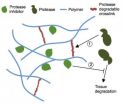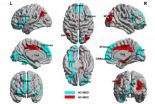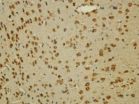(Press-News.org) Combatting the tissue degrading enzymes that cause lasting damage following a heart attack is tricky. Each patient responds to a heart attack differently and damage can vary from one part of the heart muscle to another, but existing treatments can't be fine-tuned to deal with this variation.
University of Pennsylvania researchers have developed a way to address this problem via a material that can be applied directly to the damaged heart tissue. The potentially dangerous enzymes break down this gel-like material, releasing enzyme inhibitors contained within. This responsive, balancing approach is ideal for keeping enzymes at the right level to minimize the long-term damage that can lead to congestive heart failure.
The ability of this gel to deliver enzyme inhibitors as needed suggests that the researchers' technique might also find use in other inflammation-related disorders, such as osteoarthritis where the same enzymes degrade cartilage tissue.
A study demonstrating their design's efficacy was published in the journal Nature Materials. It was led by Jason Burdick, professor of bioengineering in Penn's School of Engineering and Applied Science, and Brendan Purcell, a post-doctoral researcher in his lab. Joseph Gorman and Robert Gorman of the Department of Surgery in Penn's Perelman School of Medicine contributed to the research. The Penn team collaborated with Francis G. Spinale of the University of South Carolina School of Medicine, along with members of his research group.
"For heart attack patients, the first priority is restoring blood flow to the heart," Burdick said. "What's neglected, however, are the secondary effects that occur after a heart attack, including what's known as ventricular remodeling."
Remodeling is a phenomenon that ultimately changes the overall shape and performance of the heart. After a heart attack, the body naturally releases enzymes as part of the inflammatory response to injury. But when this response is sustained too long, those enzymes begin to break up the extracellular matrix inside the muscle tissue that makes up the walls of the heart, making it thinner and weaker. The walls balloon out under the pressure of normal heart pumping, resulting in an enlarged heart that pumps less blood with each beat.
Synthetic or lab-grown versions of inhibitors to the tissue-degrading enzymes have been used in clinical trials, but only in a non-targeted fashion. Patients receive them intravenously or orally, with the hope that the inhibitor molecules make their way to the heart.
"As you can imagine, this type of delivery can lead to off-target problems," Burdick said. "In other tissues where enzymes and inhibitors are in balance, these extra inhibitors can throw that balance off. This can cause the stiffening of joints, for example."
"That's where our approach came in," Purcell said. "We used injectable gels to deliver the inhibitors locally, rather than systemically. And to really fine-tune the targeting, the innovation with this material is that it releases the inhibitor in response to the activity level of the enzyme."
The material the researchers used is known as a hydrogel, which in this design are squishy networks of sugars that are useful in mimicking different tissue environments. By making the hydrogel out of naturally occurring sugars, the researchers were able to hold the inhibitors within the hydrogel.
"We borrowed the way this specific inhibitor is localized and retained in normal tissues," Purcell said. "The inhibitors are physically held within the gel by electrostatic interactions with these sugars."
"If we didn't include this chemistry," Burdick said, "our experiments showed that about 80 percent of the inhibitor is released within a few days. When you have these bonds, only about 20 percent of the inhibitor is released over the course of a few weeks.
The researchers then selected the chemistry of cross-linking bonds that hold the hydrogel together so that the heart tissue-damaging enzyme could break them down. This was a key to the overall design of the gel. Absent the enzyme, the gel would prevent the inhibitor molecules from escaping until they were needed.
"Once we add the enzymes, however, we can make the gel degrade away within a few hours, and we also showed that the level of enzyme correlates very nicely with how fast the gel degrades away and releases the inhibitor," Burdick said.
The researchers demonstrated this responsiveness in a petri dish, but also showed its potential for clinical effectiveness in an animal model. They used pigs, due to the anatomical similarity between porcine and human hearts.
"We used a microdialysis technique," Purcell said, "to show that, after a heart attack, local enzyme levels go way up, but when the inhibitor molecules are delivered via the gel, we see the activity level of this enzyme go down. Over the next 28 days, we also used imaging techniques to show thicker cardiac walls and less expansion and dilation of the ventricle. And, as a result, we see better performance in the heart using clinical measurements like ejection fraction, the amount of the blood the heart is pumping."
The study is part of an ongoing collaborative research effort between the Gorman Cardiovascular Research Group and the Burdick Biomaterials Laboratory, developing therapies intended to improve the heart's long-term response to a heart attack.
"While most groups working in this field are attempting to develop myocardial regenerative therapies, our team is focused on the biomechanical stabilization of the heart after heart attack," Robert Gorman said. "Most researchers working towards regenerative therapies often overlook an important fact, namely, that the overwhelming majority of patients who suffer heart attack initially have adequate heart function. We strongly believe that optimizing the function of the surviving heart muscle after heart attack will be a more realistic and effective strategy than trying to regenerate the muscle that is lost."
"What's appealing about our approach," Burdick said, "is that we are trying to intervene early. We want to attenuate the remodeling process to limit these negative outcomes and prevent the onset of congestive heart failure."
The researchers are hopeful that these results will pave the way toward clinical use in human patients, where the gel would be applied to hearts via a catheter after the acute danger of a heart attack has passed.
INFORMATION:
The research was supported by National Institutes of Health and a Veterans' Affairs Health Administration Merit Award. Manoj Charati, Shauna Dorsey and Ryan Wade of the Burdick lab, and David Lobb, Kia Zellars, Heather Doviak, Sara Pettaway, Christina Logdon, James Shuman and Parker Freels of the Cardiovascular Translational Research Center at the University of South Carolina School of Medicine also contributed to this study.
New Penn-designed gel allows for targeted therapy after heart attack
2014-03-31
ELSE PRESS RELEASES FROM THIS DATE:
New Zealand physicists split and collide ultracold atom clouds
2014-03-31
VIDEO:
Physicists from New Zealands' University of Otago have pushed the frontiers of quantum technology by developing a steerable 'optical tweezers' unit that uses intense laser beams to precisely split minute...
Click here for more information.
Physicists at New Zealand's University of Otago have pushed the frontiers of quantum technology by developing a steerable 'optical tweezers' unit that uses intense laser beams to precisely split minute clouds of ultracold atoms and to ...
Childhood virus may increase type 1 diabetes risk
2014-03-31
The study, published today in PLOS Pathogens, explored the ways the rotavirus infection contributes to autoimmune disease in mice, and researchers believe the breakthrough could be relevant to human infection with rotavirus.
The research found that it may be the "bystander effect" that causes the rotavirus infection to accelerate the onset of type 1 diabetes.
The "bystander effect" suggests that the virus provokes a strong activation of the immune system, which then spills over, allowing the immune system to attack not only the viral intruder but some of the body's ...
Role of type-2 astrocytes on the repair of spinal cord injury
2014-03-31
Increasing expression of bone morphogenetic proteins at the lesion site of the central nervous system possibly induces oligodendrocyte precursor cells to differentiate into type-2 astrocytes. While the restriction of oligodendrocyte differentiation could affect remyelination, it remains poorly understood how type-2 astrocytes regulate regeneration and functional recovery. Thus, examining the effects of type-2 astrocytes on neuronal growth is helpful in understanding the possible influential factors of oligodendrocyte precursor cells on axonal regeneration and remyelination, ...
Resting-state functional connectivity as an auxillary diagnosis of depression
2014-03-31
According to a paper published in the Neural Regeneration Research (Vol. 9, No. 2, 2014), both depressive patients and healthy controls presented typical small-world attributes, and compared with healthy controls, characteristic path length was significantly shorter in depressive patients, suggesting development toward randomization. Patients with depression showed apparently abnormal node attributes at key areas in cortical-striatal-pallidal-thalamic circuits. In addition, right hippocampus and right thalamus were closely linked with the severity of depression. An artificial ...
How does acupuncture at Baihui and Dazhui reduce brain cell apoptosis in heroin readdicts?
2014-03-31
Acupuncture has therapeutic effects on cerebral ischemia, dementia, epilepsy and other brain diseases, and also functions to repair the nervous system. Dazhui (GV14) and Baihui (GV20) are the preferred acupoints for treatment. However, whether acupuncture can treat addiction and prevent readdiction through changes to brain cell ultrastructure remains unknown. A research team from Anhui University of Traditional Chinese Medicine in China pointed out that cell apoptosis was observed in the hippocampus and frontal lobe of heroin readdicted rats by electron microscopy, and ...
Metformin does not improve heart function in patients without diabetes
2014-03-31
Although some research has suggested that metformin, a medication often used in the treatment of diabetes, may have favorable effects on ventricular (heart) function, among patients without diabetes who underwent percutaneous coronary intervention (PCI; a procedure such as stent placement used to open narrowed coronary arteries) for ST-segment elevation myocardial infarction (STEMI; a certain pattern on an electrocardiogram following a heart attack), treatment with metformin did not result in improved ventricular function, according to a JAMA study released online to coincide ...
Cleveland Clinic study shows bariatric surgery provides long-term control of diabetes
2014-03-31
Cleveland: A study by Cleveland Clinic researchers shows bariatric surgery is a highly effective and durable treatment for type 2 diabetes in obese patients, enabling nearly all surgical patients to be free of insulin and many to be free of all diabetic medications three years after surgery.
The STAMPEDE (Surgical Therapy And Medications Potentially Eradicate Diabetes Efficiently) trial was simultaneously published in the New England Journal of Medicine and presented today at the Annual Scientific Session of the American College of Cardiology in Washington, D.C.
The ...
Addicts who live in the moment may benefit most from certain kinds of treatment
2014-03-31
Drug-dependent people who least take the future into account may, paradoxically, be the ones to benefit the most from certain treatments.
The human instinct to choose instant gratification, such as a drug high, over a later benefit, such as good health — known as future or delay discounting — is strong in people with drug dependencies. An important component of addiction is failure to exert self-control in recognition of future consequences.
In a study in Clinical Psychological Science, a team of researchers has found an unexpected pattern that may provide hope for ...
Diamonds are an oil's best friend
2014-03-31
A mixture of diamond nanoparticles and mineral oil easily outperforms other types of fluid created for heat-transfer applications, according to new research by Rice University.
Rice scientists mixed very low concentrations of diamond particles (about 6 nanometers in diameter) with mineral oil to test the nanofluid's thermal conductivity and how temperature would affect its viscosity. They found it to be much better than nanofluids that contain higher amounts of oxide, nitride or carbide ceramics, metals, semiconductors, carbon nanotubes and other composite materials. ...
Academic workplace bias against parents hurts nonparents too
2014-03-31
Parents have reported before that trying to balance work and family obligations comes with career costs. But a new study from Rice University and the University of California, San Diego, shows that university workplace bias against scientists and engineers who use flexible work arrangements may increase employee dissatisfaction and turnover even for people who don't have children.
"As researchers, we're interested in understanding the gap between the traditional 9-to-5 work setting and what workers actually need," said Erin Cech, an assistant professor of sociology at ...





